The Radeon R9 280X Review: Feat. Asus & XFX - Meet The Radeon 200 Series
by Ryan Smith on October 8, 2013 12:01 AM ESTCompute
Jumping into compute, as with our synthetic benchmarks we aren’t expecting too much new here. Outside of DirectCompute GK104 is generally a poor compute GPU, which makes everything very easy for the Tahiti based 280X. At the same time compute is still a secondary function for these products, so while important the price cuts that go with the 280X are not quite as meaningful here.
As always we'll start with our DirectCompute game example, Civilization V, which uses DirectCompute to decompress textures on the fly. Civ V includes a sub-benchmark that exclusively tests the speed of their texture decompression algorithm by repeatedly decompressing the textures required for one of the game’s leader scenes. While DirectCompute is used in many games, this is one of the only games with a benchmark that can isolate the use of DirectCompute and its resulting performance.
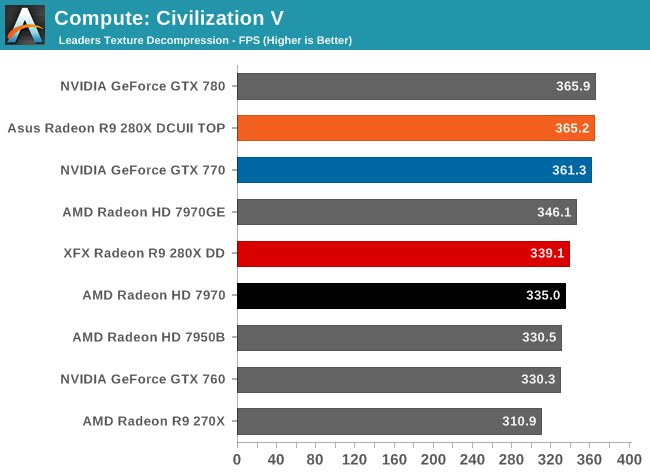
With Civilization V we’re finding that virtually every high-end GPU is running into the same bottleneck. We’ve reached the point where even GPU texture compression is CPU-bound.
Our next benchmark is LuxMark2.0, the official benchmark of SmallLuxGPU 2.0. SmallLuxGPU is an OpenCL accelerated ray tracer that is part of the larger LuxRender suite. Ray tracing has become a stronghold for GPUs in recent years as ray tracing maps well to GPU pipelines, allowing artists to render scenes much more quickly than with CPUs alone.
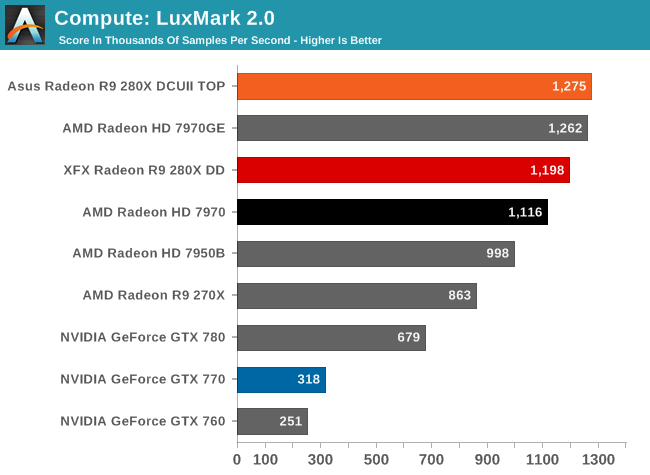
AMD simply rules the roost when it comes to LuxMark, so the only thing close to 280X here are other Tahiti parts.
Our 3rd compute benchmark is Sony Vegas Pro 12, an OpenGL and OpenCL video editing and authoring package. Vegas can use GPUs in a few different ways, the primary uses being to accelerate the video effects and compositing process itself, and in the video encoding step. With video encoding being increasingly offloaded to dedicated DSPs these days we’re focusing on the editing and compositing process, rendering to a low CPU overhead format (XDCAM EX). This specific test comes from Sony, and measures how long it takes to render a video.
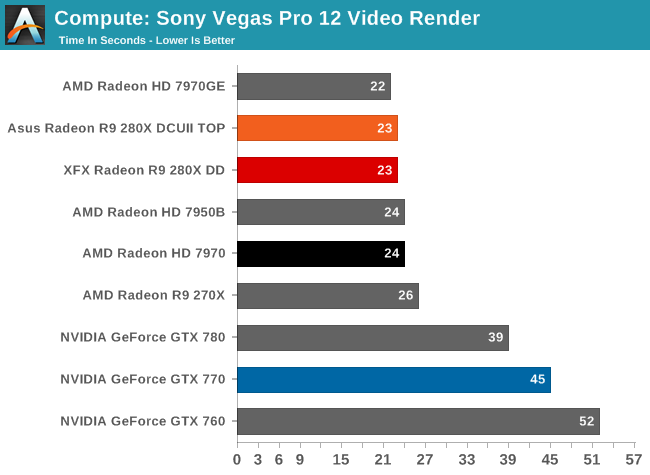
Again AMD’s strong compute performance shines through, with 280X easily topping the chart.
Our 4th benchmark set comes from CLBenchmark 1.1. CLBenchmark contains a number of subtests; we’re focusing on the most practical of them, the computer vision test and the fluid simulation test. The former being a useful proxy for computer imaging tasks where systems are required to parse images and identify features (e.g. humans), while fluid simulations are common in professional graphics work and games alike.
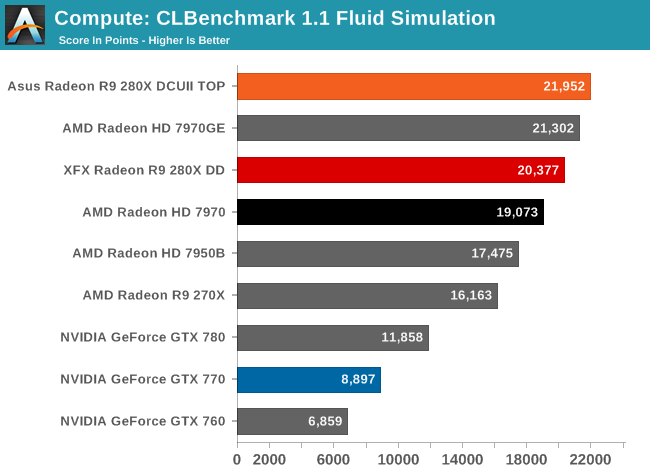
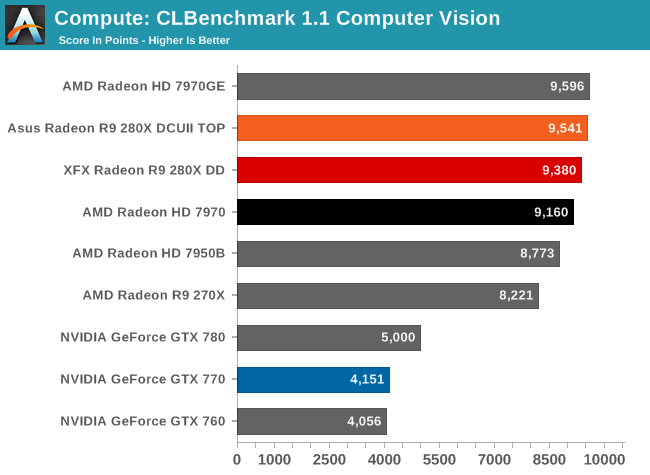
Despite the significant differences in these two workloads, in both cases 280X comes out easily on top.
Moving on, our 5th compute benchmark is FAHBench, the official Folding @ Home benchmark. Folding @ Home is the popular Stanford-backed research and distributed computing initiative that has work distributed to millions of volunteer computers over the internet, each of which is responsible for a tiny slice of a protein folding simulation. FAHBench can test both single precision and double precision floating point performance, with single precision being the most useful metric for most consumer cards due to their low double precision performance. Each precision has two modes, explicit and implicit, the difference being whether water atoms are included in the simulation, which adds quite a bit of work and overhead. This is another OpenCL test, as Folding @ Home has moved exclusively to OpenCL this year with FAHCore 17.

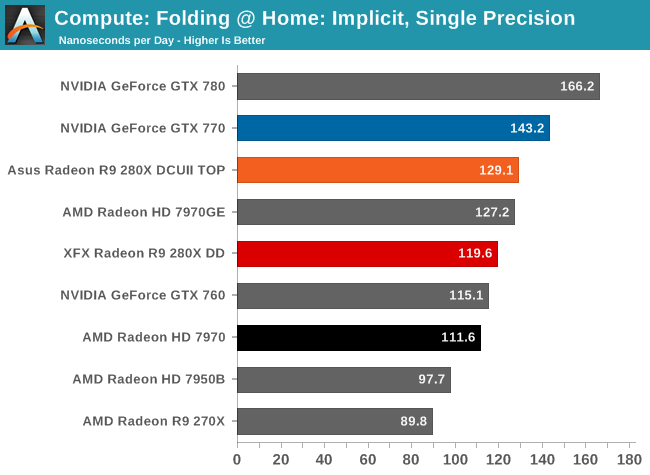

Depending on the mode and the precision, we can have wildly different results. The 280X does well in FP32 explicit, for example, but in implicit mode the 280X is now caught between the GTX 770 and GTX 760. But if we move to double precision then AMD’s native ¼ FP64 execution speed gives them a significant advantage here.
Wrapping things up, our final compute benchmark is an in-house project developed by our very own Dr. Ian Cutress. SystemCompute is our first C++ AMP benchmark, utilizing Microsoft’s simple C++ extensions to allow the easy use of GPU computing in C++ programs. SystemCompute in turn is a collection of benchmarks for several different fundamental compute algorithms, as described in this previous article, with the final score represented in points. DirectCompute is the compute backend for C++ AMP on Windows, so this forms our other DirectCompute test.
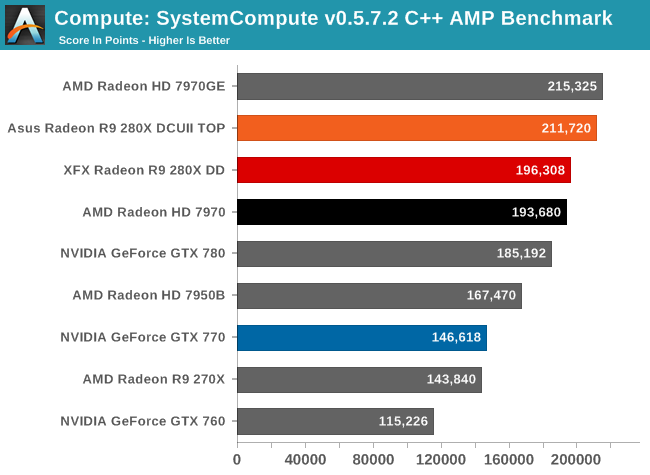
Although not by any means a blowout, yet again the 280X vies for the top here. When it comes to compute, the Tahiti based 280X is generally unopposed by anything in its price range.










151 Comments
View All Comments
alfredska - Wednesday, October 9, 2013 - link
Yes, I made a couple mistakes in trimming the fat from Ryan's writing. I should have done another proof-read myself. This wasn't the point of my post, though.Ryan's review is littered with sentence pauses that drastically slow down your ability to read the article. Some examples are: starting too many sentences with words like "ultimately" or "meanwhile"; making needless references to earlier statements; using past or present perfect tense when just past or present tense is appropriate. I wrote the above example hoping that Ryan would put it next to his own writing and see whether he can 1) read it faster, and 2) retain more information from this version.
I can accept a misspelling here and there and even some accidental word injections of which I was guilty. The fluidity needs work though. If the reader cannot glide easily between paragraphs, they will stop reading and just look at pictures.
chuck.norris.and.son - Tuesday, October 8, 2013 - link
tl:dr :( blablablaCan't you nail it down: AMD or Nvidia? Which GFX card should i buy to play Blockbuster like BF 4?
ShieTar - Tuesday, October 8, 2013 - link
How about not buying any new GFX card and investing the savings into books in order to improve your reading skills?Will Robinson - Tuesday, October 8, 2013 - link
Radeon 280X will be the sweet spot card to get for BF4.R9 290X will be the open class champ over GTX780 I suspect.
piroroadkill - Tuesday, October 8, 2013 - link
The best AMD card you can buy with your money, simply because Battlefield 4 will eventually feature the Mantle renderer which is for GCN cards only, and will probably be a killer feature.hrga - Tuesday, October 8, 2013 - link
Most moronic branding ever (at least the one to be overrun). They cutout vanilla 7850 or top end 7950 from the HD7000 lineup and call it with confusing R9/R7, unrealistically stupid marketing where nothing material stand behind those names.Another rebranding?
- Yes. [thinking. What the heck did you expect guys]
Not most successful?
- [thinking. depends on POV] Well, it's here to milk the most cash as our CPU business didnt produced anything valuable for three years. And we also must have something interesting to present in our slideshow presentation for investors. If we couldn't afford to produce whole new lineup we could always produce yet another rebranded line just like nvidia. We always learn from our (cartel) competition, and customers don't seem to have any objections on that matter.
So that's why you retain those moronically high prices?
- We just adjust that according to our competition (cartel)
But you never lower prices for HD7870 which today celebrates its second birthday and is produced on highly matured 28nm for at least six month. Instead you just rebranded it for second time after HD8860, so now we have R9 270X too. Don't you think you're customers would like to see some new designs while putting old products on discount prices?
Or at least you could introduce that R9 270, which is same old HD7870, with lower prices than todays HD7870 retail prices are?!
Instead of higher up prices for same performance (source Newgg http://imageshack.dk/imagesfree/xLh43741.jpg).
And why the heck R9 desination for this mediocre mainstream product?! You could weaselishly sell this c-rap at the end of 2011, but "Hello AMD!" It the end of 2013.
Pitcairn used in HD7800/HD8800 seriesis is smaller chip than Evergreen in HD5800, which only three years ago was produced on troublesome early 40nm process while this is two year old design now produced on highly mature TSMC 28nm-HK node for at least six month with far better yields? HD5850 had same or even lower prices at EOL (only year after introduction) than todays two year old Pitcairn desing. How do you explain that?
- Well ...Milking you know ... When you have good cartel environment like we have competing with nvidia we could sky rocket prices. And you know even crappy Intels Knights Corner chips today produced at 22nm would be any cheaper because Intel knows how to milk moneys on their tick-tock performance introductions and they certainly would gave up that experience in case of "Chip Previously Known as Larabee" (CPKL)
labodhibo - Tuesday, October 8, 2013 - link
Must read this.. totally different perspective:http://www.techspot.com/review/722-radeon-r9-270x-...
AssBall - Tuesday, October 8, 2013 - link
Well done review. I kinda like what Asus did with its 280x version.Typo: "Asus calls it “CoolTech” and it’s essentially an effort to build a fan that’s blow a an axial fan and a blower (radial) fan at the same time,"
[blow -> both?]
zlandar - Tuesday, October 8, 2013 - link
This is why I wanted the Asus 770 card also in the recent 770 GTX roundup. The cooler design seems superior for single GPU purposes as long as you have the room for it in your case.AxialLP7 - Tuesday, October 8, 2013 - link
Not trying to be AFC, just want to make sense of this: "Asus calls it “CoolTech” and it’s essentially an effort to build a fan that’s blow a an axial fan and a blower (radial) fan at the same time, explaining the radial-like center and axial-like outer edge of the fan." Can someone help? This is in the "ASUS RADEON R9 280X DIRECTCU II TOP" section...